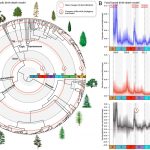Plant Science Research Weekly: November 20, 2020
Review: Integration of reactive oxygen species and hormone signaling during abiotic stress
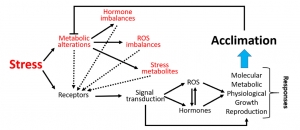
During its life cycle, a plant experiences many types of abiotic stress including drought. While waiting for the next drops of water, a thirsty plant acclimates by initiating a series of tolerance responses. Stress perception is followed by stress-induced signaling which can include reactive oxygen species (ROS) production, phytohormone activation, gene expression regulation, and kinase/phosphatase signaling pathways. In their review, Devireddy et al. outline the extensive cellular and molecular mechanisms of ROS interaction with phytohormones in response to drought, heat, cold, and salinity. ROS integrates with upstream or downstream of phytohormone signaling pathways individually or mediates crosstalk between the phytohormones in an antagonistic or synergistic manner. The ROS-mediated stress responses range from cellular redox homeostasis to stomatal opening/closing and shoot and root growth. When a plant faces a combination of abiotic stresses, it is potentially the level of ROS that determines which stress response wins over the others. These responses are complex: they act at cellular, tissue, and organ levels and recruit multiple stress response networks, all maintain the growth and development until the next drop of water arrives or the next cooling breeze passes by. (Summary by Roxana Khoshravesh @RoxiKh) Plant J. 10.1111/tpj.15010
Alternative CAM and water-saving flux modes into C3 leaf metabolic model
 Crassulacean acid metabolism (CAM) is a photosynthetic adaptation pathway in arid environments to minimize water loss by opening the stomata at night, when the temperature and therefore water loss due to transpiration is lower. Carbon dioxide is initially fixed at night and stored in the vacuole. Engineering CAM photosynthesis into a C3 crop plant is of a great interest to maximize the water-use efficiency for plants grown in hot or arid climates. Tӧpfer et al. constructed a time-resolved, large-scale metabolic leaf model and coupled it to a gas-exchange model to investigate the effect of temperature and relative humidity on plant metabolism. They found the vacuolar storage capacity of the leaf is a major determinant of the extent of CAM, and without a higher vacuole-to-cytoplasm ratio it is unlikely that a full CAM cycle can be introduced into a C3 leaf. Their model also identified an alternative CAM model comprising the reversibility of isocitrate dehydrogenase in mitochondria that is potentially beneficial to fixing carbon at night. More significantly, the water-saving effect of the CAM model is simulated across a large range of environments that are normally faced by crop plants in temperate and hot climates. This study sheds light on improving the water-use efficiency of C3 plants by introducing alternative CAM metabolism under wide range of environmental conditions. (Summary by Min May Wong @wongminmay) Plant Cell 10.1105/tpc.20.00132
Crassulacean acid metabolism (CAM) is a photosynthetic adaptation pathway in arid environments to minimize water loss by opening the stomata at night, when the temperature and therefore water loss due to transpiration is lower. Carbon dioxide is initially fixed at night and stored in the vacuole. Engineering CAM photosynthesis into a C3 crop plant is of a great interest to maximize the water-use efficiency for plants grown in hot or arid climates. Tӧpfer et al. constructed a time-resolved, large-scale metabolic leaf model and coupled it to a gas-exchange model to investigate the effect of temperature and relative humidity on plant metabolism. They found the vacuolar storage capacity of the leaf is a major determinant of the extent of CAM, and without a higher vacuole-to-cytoplasm ratio it is unlikely that a full CAM cycle can be introduced into a C3 leaf. Their model also identified an alternative CAM model comprising the reversibility of isocitrate dehydrogenase in mitochondria that is potentially beneficial to fixing carbon at night. More significantly, the water-saving effect of the CAM model is simulated across a large range of environments that are normally faced by crop plants in temperate and hot climates. This study sheds light on improving the water-use efficiency of C3 plants by introducing alternative CAM metabolism under wide range of environmental conditions. (Summary by Min May Wong @wongminmay) Plant Cell 10.1105/tpc.20.00132
Nitrate inhibits nodule organogenesis through inhibition of cytokinin biosynthesis in Lotus japonicus
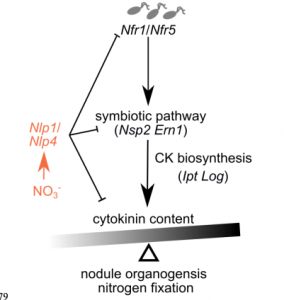 The symbiotic association between legumes and nitrogen-fixing rhizobia leads to the formation of nodules in roots, which supply nitrogen to the plant in low soil nitrate condition. In contrast, the presence of high nitrate reduces nodule formation. Cytokinin (CK) biosynthesis plays a major role in nodule organogenesis, but the impact of high nitrate on CK is still unknown. In this paper, Lin et al showed that the presence of high nitrate inhibits the expression of cytokinin biosynthesis genes. Further study on cytokinin biosynthesis mutants showed a reduction in cytokinin content, nodule number and nitrogenase activity in the presence of high nitrate. Additional study also showed nitrate inhibition of cytokinin signaling requires nitrate signaling genes like, NLP1 and NLP4. RNASeq analysis and gene expression analysis also showed NLPs mediating the nitrate regulation of early nodulation signaling genes like NFs. Overall, this study indicates a different cytokinin response to nitrate in legumes compared to non-legumes. Further study on NLPs and their role on regulating cytokinin and various NF signaling would help in optimizing nitrogen fixation in legumes and support efforts to develop symbiotic nitrogen fixation in non-legumes. (Summary by Sunita Pathak @psunita980) bioRxiv 10.1101/2020.11.03.366971
The symbiotic association between legumes and nitrogen-fixing rhizobia leads to the formation of nodules in roots, which supply nitrogen to the plant in low soil nitrate condition. In contrast, the presence of high nitrate reduces nodule formation. Cytokinin (CK) biosynthesis plays a major role in nodule organogenesis, but the impact of high nitrate on CK is still unknown. In this paper, Lin et al showed that the presence of high nitrate inhibits the expression of cytokinin biosynthesis genes. Further study on cytokinin biosynthesis mutants showed a reduction in cytokinin content, nodule number and nitrogenase activity in the presence of high nitrate. Additional study also showed nitrate inhibition of cytokinin signaling requires nitrate signaling genes like, NLP1 and NLP4. RNASeq analysis and gene expression analysis also showed NLPs mediating the nitrate regulation of early nodulation signaling genes like NFs. Overall, this study indicates a different cytokinin response to nitrate in legumes compared to non-legumes. Further study on NLPs and their role on regulating cytokinin and various NF signaling would help in optimizing nitrogen fixation in legumes and support efforts to develop symbiotic nitrogen fixation in non-legumes. (Summary by Sunita Pathak @psunita980) bioRxiv 10.1101/2020.11.03.366971
The halophyte seashore paspalum uses adaxial leaf papillae for sodium sequestration
 Global warming and intensive farming are increasing soil salinity, which is predicted to affect 30% of cultivated land by 2050. Salinity represents a major threat for agriculture as most crops drastically reduce their growth and productivity in saline environments. Understanding the strategies used by halophytes (salt-tolerant plants) and transferring them to glycophytes (salt-intolerant plants) could be a means to improve crop yield in saline soils. For example, unraveling the mechanisms underlying the capacity of the salt-tolerant Paspalum vaginatum to survive near the seashore could be valuable to improve the performance of salt-sensitive maize and sorghum, belonging to the same subfamily (Panicoideae), in response to high salt concentration. Spiekerman and Devos investigated the differential response to salinity of two closely related panicoid species – P. vaginatum ‘HI10’ and P. distichum ‘Spence’ – showing increased and decreased growth under saline conditions respectively. Both accessions contain dense rows of papillae on the adaxial leaf epidermis. However, detailed morphological analyses revealed that ‘HI10’ forms larger papillae. Beside the proposed function as Na+ sinks, these big epidermal structures could also regulate water loss via transpiration by hiding stomata. The authors used the CoroNa Green fluorescent dye to measure the Na+ content in peeled papillae and found a significant increase in fluorescence in ‘HI10’, but not in ‘Spence’, in response to salt treatment, suggesting an association between salt tolerance and the ability to sequester Na+ in specialized leaf epidermal structures. This study paves the way to the biotechnological application of halophyte-specific mechanisms to improve salt tolerance in crops. (Summary and image adaptation by Michela Osnato @michela_osnato) Plant Physiol. 10.1104/pp.20.00796
Global warming and intensive farming are increasing soil salinity, which is predicted to affect 30% of cultivated land by 2050. Salinity represents a major threat for agriculture as most crops drastically reduce their growth and productivity in saline environments. Understanding the strategies used by halophytes (salt-tolerant plants) and transferring them to glycophytes (salt-intolerant plants) could be a means to improve crop yield in saline soils. For example, unraveling the mechanisms underlying the capacity of the salt-tolerant Paspalum vaginatum to survive near the seashore could be valuable to improve the performance of salt-sensitive maize and sorghum, belonging to the same subfamily (Panicoideae), in response to high salt concentration. Spiekerman and Devos investigated the differential response to salinity of two closely related panicoid species – P. vaginatum ‘HI10’ and P. distichum ‘Spence’ – showing increased and decreased growth under saline conditions respectively. Both accessions contain dense rows of papillae on the adaxial leaf epidermis. However, detailed morphological analyses revealed that ‘HI10’ forms larger papillae. Beside the proposed function as Na+ sinks, these big epidermal structures could also regulate water loss via transpiration by hiding stomata. The authors used the CoroNa Green fluorescent dye to measure the Na+ content in peeled papillae and found a significant increase in fluorescence in ‘HI10’, but not in ‘Spence’, in response to salt treatment, suggesting an association between salt tolerance and the ability to sequester Na+ in specialized leaf epidermal structures. This study paves the way to the biotechnological application of halophyte-specific mechanisms to improve salt tolerance in crops. (Summary and image adaptation by Michela Osnato @michela_osnato) Plant Physiol. 10.1104/pp.20.00796
Seed dormancy of 80 tropical montane forest species in Sri Lanka, the first dormancy profile for a tropical montane forest community ($)

Seed dormancy is a crucial mechanism to synchronize germination with the most suitable environmental conditions. Therefore, assessing its prevalence at the community level allows us to understand how plants adapt to their local environment. In this paper, Athugala and colleagues build the first dormancy profile for a tropical montane forest community. Eighty species from three forests in Sri Lanka were submitted to different germination experiments to determine whether their seeds exhibit dormancy and, in case they did, establish its class. 69% of the species had dormant seeds, with physiological dormancy (PD) being the most frequent dormancy class. The authors discuss that dormancy ensures that seeds germinate during the year’s least dry period. Interestingly, plant growth form was significantly correlated with seed dormancy classes: most trees and shrubs seeds had PD while the seeds of most herb species were non-dormant. In contrast, canopy and understory species did not differ significantly in their dormancy profiles. Given this, the study outlines the importance of dormancy in the regeneration of the different elements of tropical montane forests, making it an obligate reading for future studies in this ecosystem. (Summary by Carlos A. Ordóñez-Parra @caordonezparra) Plant Biol. 10.1111/plb.13203
CLAVATA signaling ensures reproductive development in plants across thermal environments
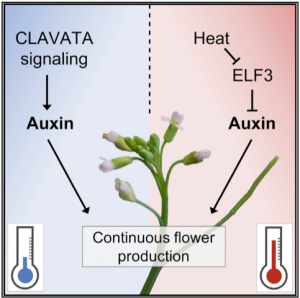 Plant reproduction and development requires robust signaling pathways that integrate environmental queues such as temperature. In Arabidopsis, the formation of flower primordia from the inflorescence meristem (IM) depends on the proliferation/ differentiation balance and is regulated by auxin and the conserved CLAVATA3 (CLV3) signaling pathway. CLV3 acts through many receptors to negatively regulate the WUSCHEL transcription factor, and thus proliferation, in the IM. Among these receptors, the CLAVATA2/CORYNE (CLV2/CRN) complex acts as a negative regulator of cell proliferation in the IM independently of other CLV3 receptors, however, recent work has shed light on a new function. Through combinatorial null mutant analyses, Jones et al. showed that CLV2/CRN contributes to flower primordia outgrowth in cooperation with the CLAVATA3 INSENSITIVE RECEPTOR KINASE1/2/3/4 family of co-receptors and temperature-dependent auxin signaling. Flower outgrowth defects observed in clv2/crn plants are suppressed at high temperatures. Mutants of EARLY FLOWERING 3 (ELF3), a thermomorphogenesis transcriptional repressor, introgressed in the crn background (crn elf3 double mutant) also suppressed the outgrowth defects, thus linking CLAVATA signaling to thermomorphogenetic pathways. RNA-seq analysis of crn plants revealed decreased expression of YUCCA auxin biosynthetic genes, whereas ectopic YUC1 expression in developing flower primordia of crn plants suppresses flower outgrowth defects at high temperatures but not as efficiently in cold/ambient temperatures, suggesting that YUCCA genes contribute to heat-induced suppression. This paper highlights a new buffering mechanism to ensure sustained flower production across thermal conditions, a signaling pathway that could be deployed to help mitigate the impacts of heat due to global warming. (Summary by Jesus Leon @jesussaur) Curr. Biol. 10.1016/j.cub.2020.10.008
Plant reproduction and development requires robust signaling pathways that integrate environmental queues such as temperature. In Arabidopsis, the formation of flower primordia from the inflorescence meristem (IM) depends on the proliferation/ differentiation balance and is regulated by auxin and the conserved CLAVATA3 (CLV3) signaling pathway. CLV3 acts through many receptors to negatively regulate the WUSCHEL transcription factor, and thus proliferation, in the IM. Among these receptors, the CLAVATA2/CORYNE (CLV2/CRN) complex acts as a negative regulator of cell proliferation in the IM independently of other CLV3 receptors, however, recent work has shed light on a new function. Through combinatorial null mutant analyses, Jones et al. showed that CLV2/CRN contributes to flower primordia outgrowth in cooperation with the CLAVATA3 INSENSITIVE RECEPTOR KINASE1/2/3/4 family of co-receptors and temperature-dependent auxin signaling. Flower outgrowth defects observed in clv2/crn plants are suppressed at high temperatures. Mutants of EARLY FLOWERING 3 (ELF3), a thermomorphogenesis transcriptional repressor, introgressed in the crn background (crn elf3 double mutant) also suppressed the outgrowth defects, thus linking CLAVATA signaling to thermomorphogenetic pathways. RNA-seq analysis of crn plants revealed decreased expression of YUCCA auxin biosynthetic genes, whereas ectopic YUC1 expression in developing flower primordia of crn plants suppresses flower outgrowth defects at high temperatures but not as efficiently in cold/ambient temperatures, suggesting that YUCCA genes contribute to heat-induced suppression. This paper highlights a new buffering mechanism to ensure sustained flower production across thermal conditions, a signaling pathway that could be deployed to help mitigate the impacts of heat due to global warming. (Summary by Jesus Leon @jesussaur) Curr. Biol. 10.1016/j.cub.2020.10.008
Leaf angle control across the sorghum canopy
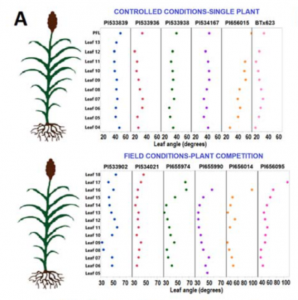 In a rosette-forming plant like Arabidopsis, leaf radial angle is optimized to prevent self-shielding. By contrast, in a plant such as sorghum, leaf vertical angle affects self-shading. A “smart canopy” model has been proposed in which upper leaves have a more upright orientation to allow more light to reach the lower leaves. Mantilla-Perez looked at leaf angles in six sorghum accessions in control and field conditions. None showed the “smart canopy” arrangement of leaf angles. They next looked at the genetic architecture of leaf angle, using plant width as a proxy. They identified several regions associated with width variation, some of which affected multiple leaf levels and other affecting only a few. Genes involved in brassinosteroid or auxin signaling (BZR1/BES1 and Dw3) affected leaves at all levels but with variable effects, which could be due to variations in expression level. They found that the BZR1/BES1 expression gradient together with Dw3, partly explains the observed leaf angle distribution across the plant in all genetic backgrounds. This finding provides a foundation for improving sorghum light interception, and therefore productivity. (Summary by Mary Williams @PlantTeaching) Plant Physiol. 10.1104/pp.20.00632
In a rosette-forming plant like Arabidopsis, leaf radial angle is optimized to prevent self-shielding. By contrast, in a plant such as sorghum, leaf vertical angle affects self-shading. A “smart canopy” model has been proposed in which upper leaves have a more upright orientation to allow more light to reach the lower leaves. Mantilla-Perez looked at leaf angles in six sorghum accessions in control and field conditions. None showed the “smart canopy” arrangement of leaf angles. They next looked at the genetic architecture of leaf angle, using plant width as a proxy. They identified several regions associated with width variation, some of which affected multiple leaf levels and other affecting only a few. Genes involved in brassinosteroid or auxin signaling (BZR1/BES1 and Dw3) affected leaves at all levels but with variable effects, which could be due to variations in expression level. They found that the BZR1/BES1 expression gradient together with Dw3, partly explains the observed leaf angle distribution across the plant in all genetic backgrounds. This finding provides a foundation for improving sorghum light interception, and therefore productivity. (Summary by Mary Williams @PlantTeaching) Plant Physiol. 10.1104/pp.20.00632
Repeated gain and loss of a single gene modulates the evolution of vascular plant pathogen lifestyles

Within the bacterial genus Xanthomonas there are many plant pathogens, some of which colonize living cells within leaves, and others of which are vascular pathogens that colonize and spread through vascular tissues. Gluck-Thaler et al. looked at genomes from sets of closely related bacteria that are either vascular or nonvascular plant pathogens. They identified a gene, cbsA, encoding a cell wall–degrading cellobiohydrolase that is found in almost all vascular pathovars and absent from the nonvascular ones. Remarkably, heterologous expression of cbsA bestows vascular pathogenesis to a nonvascular pathogen. Further analysis indicates that the presence of cbsA is ancestral, that it has been repeatedly lost in nonvascular pathovars, and also that it has been regained in some pathovars through horizontal gene transfer. In other words, “the repeated gain and loss of a single gene can act as a phenotypic switch.” (Summary by Mary Williams @PlantTeaching) Science 10.1126/sciadv.abc4516
The rise of angiosperms pushed conifers to decline during global cooling
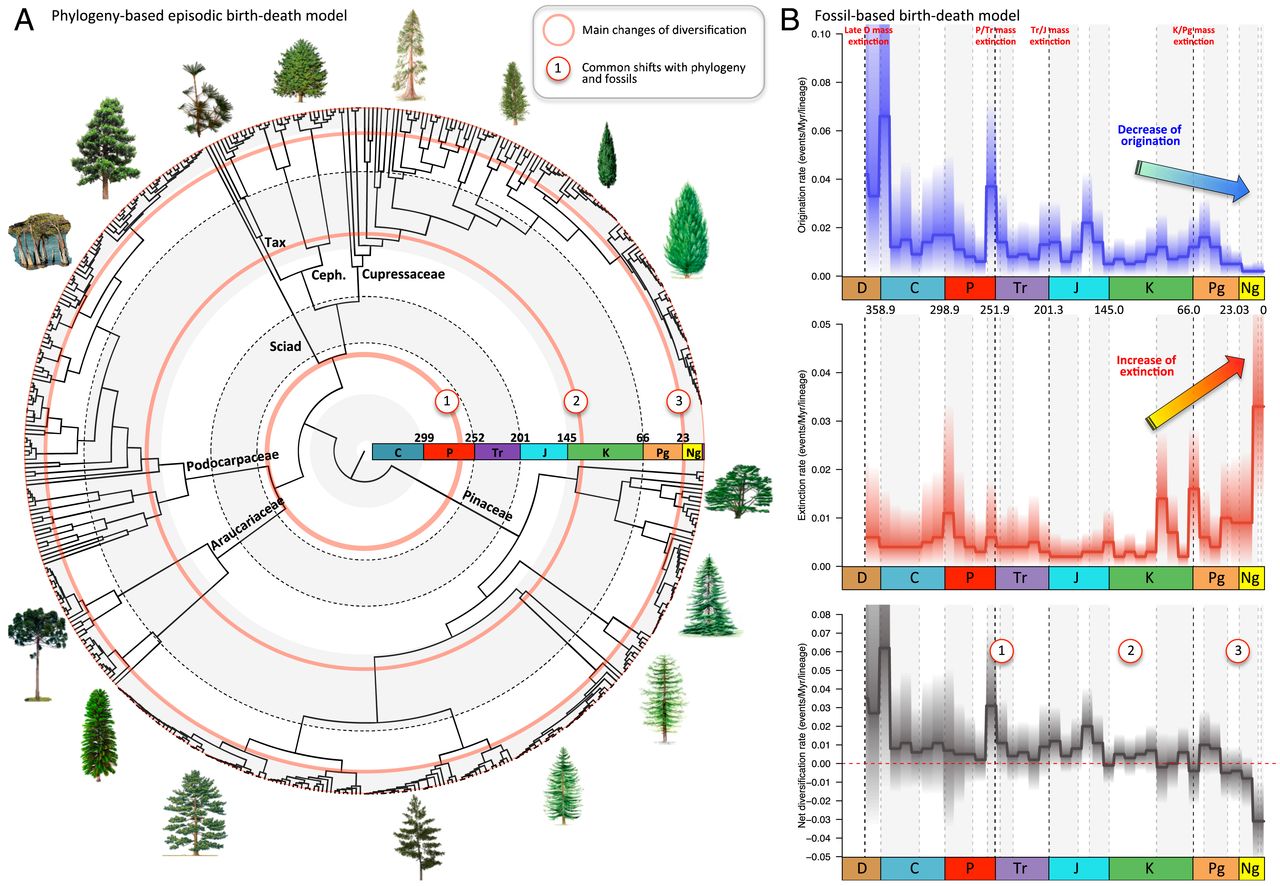
During the Triassic and Jurassic periods (approximately 250 – 140 million years ago), Earth was dominated by gymnosperms including conifers. Today, the number of species and individuals is greatly reduced from their heyday, and instead Earth is dominated by angiosperms. Although it is widely stated that angiosperms outcompeted gymnosperms and pushed them to the harsher high-altitude and high-latitude regions, this idea has not been rigorously proven. Now, Condamine et al. have used a “paleoenvironment-dependent diversification model (PDDM) applied to both the conifer phylogeny and the fossil record”. Their data rule out the hypothesis that a mass extinction event such as one caused by climate change led to the decline in conifers. Instead, they show that the accelerated rate of extinction of conifers was most likely caused by direct competition by angiosperms, compounded with the effect of global cooling. (Summary by Mary Williams @PlantTeaching) Proc. Natl. Acad. Sci. USA 10.1073/pnas.2005571117



